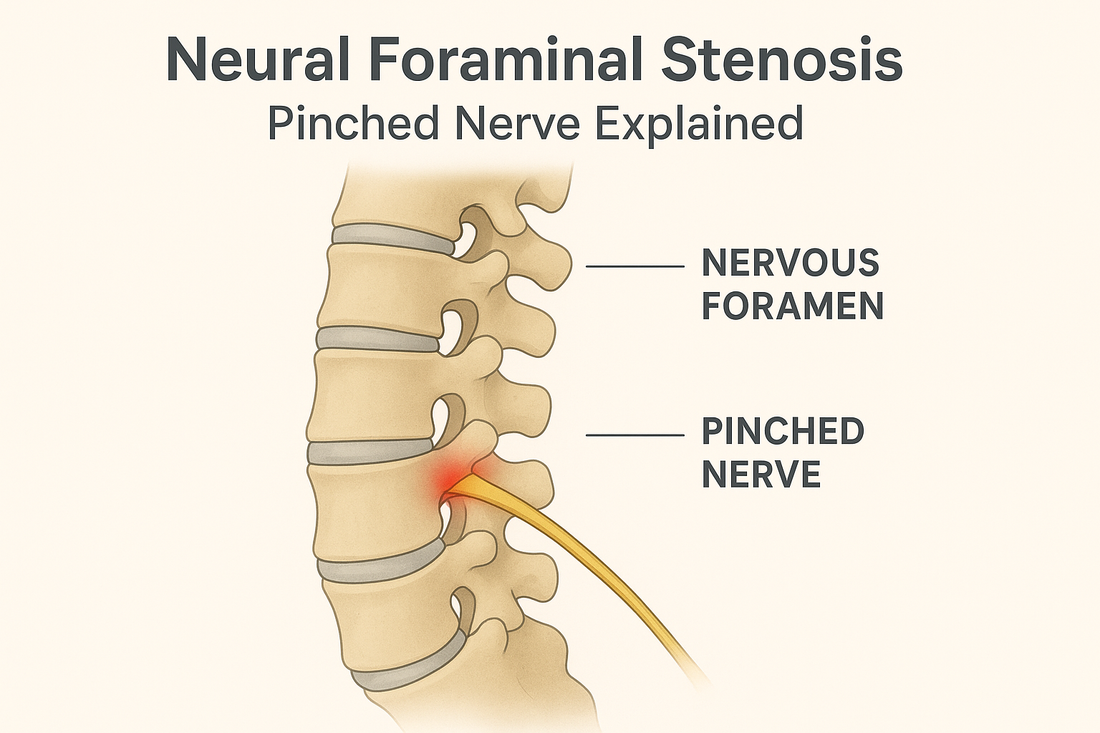
Neural Foraminal Stenosis: Symptoms, Causes, and Effective Treatments
Share
![]()
![]()
![]()
![]()
![]()
![]()
![]()
![]()
![]()
![]()
![]()
![]()
![]()
![]()
![]() Neural Foraminal Stenosis: Symptoms, Causes, and Effective Treatments
Neural Foraminal Stenosis: Symptoms, Causes, and Effective Treatments
Neural foraminal stenosis, also known as a pinched nerve in the spine, is a common condition that can affect people of all ages but becomes more frequent with age, arthritis, or poor posture. The neural foramina are tiny openings on the sides of the spine that allow spinal nerves to pass through. When these spaces narrow due to inflammation, arthritis, herniated discs, or spinal degeneration, the nerves can get compressed—leading to pain, numbness, tingling, or weakness.
Types of Neural Foraminal Stenosis
Neural foraminal stenosis can occur anywhere along the spine, but some regions are more prone than others:
1. Cervical Foraminal Stenosis (Neck)
When the narrowing happens in the cervical spine (neck), symptoms may include neck pain, tingling, numbness, or weakness radiating down the arm.
2. Thoracic Foraminal Stenosis (Mid-Back)
Less common, thoracic stenosis affects the mid-back. Symptoms can include localized pain, stiffness, or tingling in the middle spine region.
3. Lumbar Foraminal Stenosis (Lower Back)
The most common type, lumbar stenosis, causes lower back pain, numbness, tingling, or weakness that radiates down one or both legs (sciatica-like symptoms).
Common Symptoms of Spinal Foraminal Narrowing
Symptoms vary depending on the location of the stenosis, but often include:
-
Back or neck pain
-
Tingling or “pins and needles” sensation
-
Numbness in arms, hands, legs, or feet
-
Muscle weakness
-
Difficulty walking or standing for long periods
These symptoms typically worsen as the narrowing becomes more severe.
Causes of Neural Foraminal Stenosis
This condition usually develops gradually due to wear and tear on the spine. The most common causes include:
-
Arthritis & Bone Spurs – overgrowth of bone narrowing the space
-
Degenerative Disc Disease – worn-out spinal discs lose cushioning
-
Herniated Discs – bulging discs pressing on nerves
-
Poor Posture or Repetitive Movements – straining the spinal structure
-
Spinal Injuries or Trauma
-
Inflammatory Diseases such as lupus
-
Cysts or Growths inside the spinal canal
How Neural Foraminal Stenosis is Diagnosed
A healthcare provider may recommend:
-
X-rays – to check bone changes or misalignments
-
MRI scans – to show nerve compression and spinal discs
-
CT scans – for detailed images of bone structure
-
Electromyography (EMG) & Nerve Conduction Tests – to measure nerve function
Treatment Options for Neural Foraminal Stenosis
Non-Surgical Treatments
-
Anti-inflammatory medications to reduce pain and swelling
-
Physical therapy to strengthen back muscles and improve posture
-
Epidural steroid injections for targeted pain relief
-
Lifestyle adjustments like posture correction, ergonomic seating, and weight management
At-Home Management
-
Gentle stretching and strengthening exercises
-
Sleeping on a supportive mattress and pillow
-
Heat or ice therapy for pain relief
Surgical Treatments (Severe Cases)
If conservative care doesn’t help, surgical options may include:
-
Foraminotomy – widening the foraminal space
-
Discectomy – removing herniated disc material
-
Laminectomy – removing part of the vertebra to relieve pressure
-
Spinal Fusion – stabilizing vertebrae by fusing them together
Prevention and Long-Term Outlook
While you can’t always prevent spinal stenosis, healthy lifestyle habits can reduce your risk:
-
Maintain good posture while sitting, standing, and working
-
Exercise regularly to strengthen back and core muscles
-
Use proper techniques when lifting heavy objects
-
Sleep with supportive bedding to protect spinal alignment
-
Manage inflammatory conditions with medical guidance
Most people improve with conservative treatment, but severe cases may require surgery to prevent long-term nerve damage.
When to See a Doctor
Seek medical advice if you experience:
-
Persistent or worsening back/neck pain
-
Weakness in arms or legs
-
Numbness or tingling spreading down limbs
-
Sudden loss of mobility or bladder/bowel control (emergency)
Final Thoughts
Neural foraminal stenosis is a common but manageable spinal condition. Early diagnosis and treatment—whether through physical therapy, medication, or surgical options—can help prevent long-term complications and improve your quality of life.
If you suspect you have symptoms of spinal nerve compression, consult a healthcare provider for proper evaluation and treatment.
